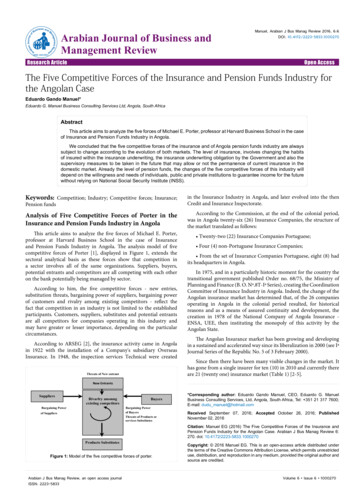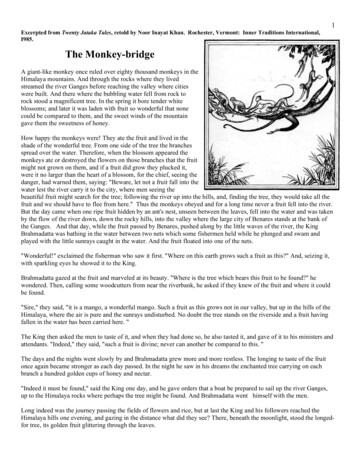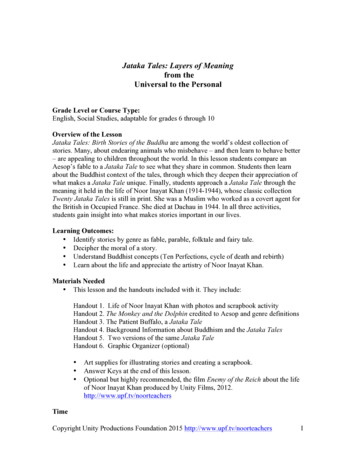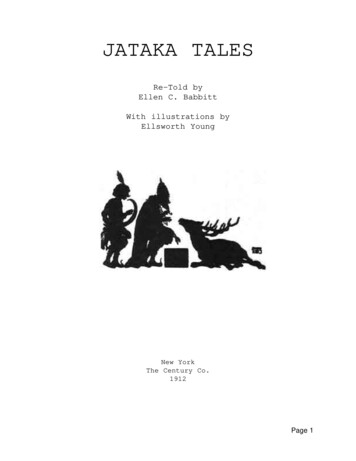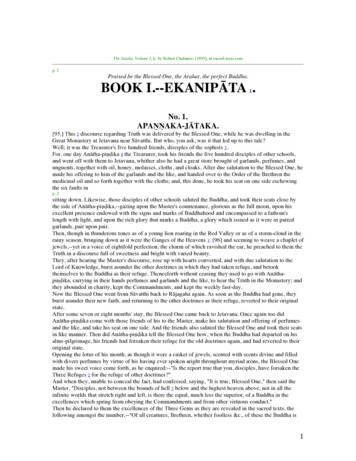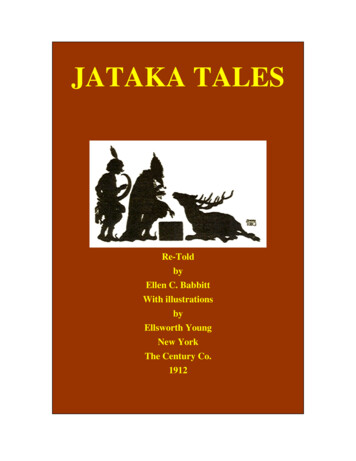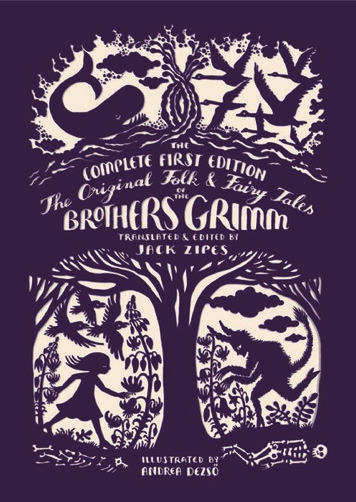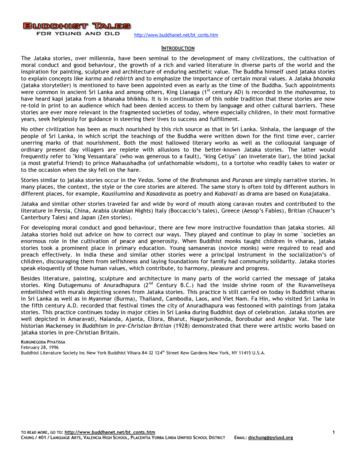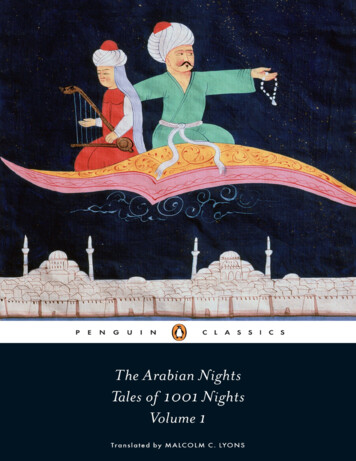
Transcription
PENGUINCLASSICSTHE ARABIAN NIGHTSTALES OF 1001 NIGHTSVOLUME 1MALCOLM C. LYONS,sometime Sir Thomas Adams Professor of Arabic atCambridge University and a life Fellow of Pembroke College, Cambridge,is a specialist in the field of classical Arabic Literature. His publishedworks include the biography Saladin: The Politics of the Holy War, TheArabian Epic: Heroic and Oral Storytelling, Identification and Identity inClassical Arabic Poetry and many articles on Arabic literature.URSULA LYONS,formerly an Affiliated Lecturer at the Faculty of OrientalStudies at Cambridge University and, since 1976, an Emeritus Fellow ofLucy Cavendish College, Cambridge, specializes in modern Arabicliterature.ROBERT IRWINis the author of For Lust of Knowing: The Orientalists andTheir Enemies, The Middle East in the Middle Ages, The Arabian Nights: ACompanion and numerous other specialized studies of Middle Easternpolitics, art and mysticism. His novels include The Limits of Vision, TheArabian Nightmare, The Mysteries of Algiers and Satan Wants Me.
Volume 1Nights 1 to 294Translated by MALCOLM C. LYONS,with URSULA LYONSIntroduced and Annotated by ROBERT IRWINPENGUIN BOOKS
PENGUIN CLASSICSPublished by the Penguin GroupPenguin Books Ltd, 80 Strand, London WC2R 0RL, EnglandPenguin Group (USA) Inc., 375 Hudson Street, New York, New York 10014, USAPenguin Group (Canada), 90 Eglinton Avenue East, Suite 700, Toronto, Ontario, Canada M4P 2Y3(a division of Pearson Penguin Canada Inc.)Penguin Ireland, 25 St Stephen’s Green, Dublin 2, Ireland (a division of Penguin Books Ltd)Penguin Group (Australia), 250 Camberwell Road, Camberwell, Victoria 3124, Australia(a division of Pearson Australia Group Pty Ltd)Penguin Books India Pvt Ltd, 11 Community Centre, Panchsheel Park, New Delhi – 110 017,IndiaPenguin Group (NZ), 67 Apollo Drive, Rosedale, North Shore 0632, New Zealand(a division of Pearson New Zealand Ltd)Penguin Books (South Africa) (Pty) Ltd, 24 Sturdee Avenue, Rosebank,Johannesburg 2196, South AfricaPenguin Books Ltd, Registered Offices: 80 Strand, London WC2R 0RL, Englandwww.penguin.comTranslation of Nights 1 to 294, Note on the Translation and Note on the Textcopyright Malcolm C. Lyons, 2008Translation of ‘The story of Ali Baba and the forty thieves killed by a slave girl’ and ‘TranslatingGalland’copyright Ursula Lyons, 2008Introduction, Glossary, Further Reading and Chronology copyright Robert Irwin, 2008All rights reservedThe moral right of the translators and editor has been assertedText illustrations design by Coralie Bickford-Smith; images: Gianni Dagli Orti/Museo Correr,Venice/The Art ArchiveExcept in the United States of America, this book is sold subject to the condition that it shall not,
by way of trade or otherwise, be lent, re-sold, hired out, or otherwise circulated without thepublisher’s prior consent in any form of binding or cover other than that in which it is publishedand without a similar condition including this condition being imposed on the subsequentpurchaserISBN: 978-0-14-194350-3
Editorial NoteIntroductionA Note on the TranslationA Note on the TextTranslating GallandThe Arabian Nights: Nights 1 to 294The story of Ali Baba and the forty thieves killed by a slave girlGlossaryChronologyFurther ReadingMapsThe ‘Abbasid Caliphate in the Ninth CenturyBaghdad in the Ninth CenturyCairo in the Fourteenth CenturyIndex of Nights and Stories
This new English version of The Arabian Nights (also known as TheThousand and One Nights) is the first complete translation of the Arabictext known as the Macnaghten edition or Calcutta II since RichardBurton’s famous translation of it in 1885–8. A great achievement in itstime, Burton’s translation nonetheless contained many errors, and evenin the 1880s his English read strangely.In this new edition, in addition to Malcolm Lyons’s translation of allthe stories found in the Arabic text of Calcutta II, Ursula Lyons hastranslated the tales of Aladdin and Ali Baba, as well as an alternativeending to ‘The seventh journey of Sindbad’, from Antoine Galland’seighteenth-century French. (For the Aladdin and Ali Baba stories nooriginal Arabic text has survived and consequently these are classed as‘orphan stories’.)The text appears in three volumes, each with an introduction, which,in Volume 1, discusses the strange nature of the Nights; in Volume 2,their history and provenance; and, in Volume 3, the influence the taleshave exerted on writers through the centuries. Volume 1 also includes anexplanatory note on the translation, a note on the text and anintroduction to the ‘orphan stories’ (‘Editing Galland’), in addition to a
chronology and suggestions for further reading. Footnotes, a glossaryand maps appear in all three volumes.As often happens in popular narrative, inconsistencies andcontradictions abound in the text of the Nights. It would be easy toemend these, and where names have been misplaced this has been doneto avoid confusion. Elsewhere, however, emendations for which there isno textual authority would run counter to the fluid and uncritical spiritof the Arabic narrative. In such circumstances no changes have beenmade.
The story collection of The Arabian Nights has drawn on many culturesand sources – Indian, Persian, Greek. One of its parallel sources, whichdrew on the same ancient Indian materials, is a Sanskrit text known asthe Kathasaritsagara, or ‘The Ocean of the Streams of Story’, compiled bythe eleventh-century author Somadeva. The Arabian Nights is, like theKathasaritsagara, a vast storytelling ocean in which the readers can losethemselves. One story, like a wave, is absorbed into the one that follows.The drift of the narrative tides carries us, like Sindbad, to strange places,and the further from home, the stranger those places are. Within thestories themselves, the sea operates as the agent of destiny which carriesships, men and magically sealed bottles and casts them upon unexpectedshores: the Island of Waq-Waq where the women grow from trees, theisland of the Magnetic Mountain presided over by its talismanic statue,the Black Islands of the Ensorcelled Prince and the islands of China. Thetides are unpredictable, and men’s fortunes founder and are wreckedupon the sea of destiny.The vastness and complexity of the Nights is mesmerizing. In her story‘The Djinn in the Nightingale’s Eye’ (1994), A. S. Byatt has written:What delights above all in the Arabian Nights is its form. Story is embedded in story, story
sprouts out of the midst of story, like the Surinam toads out of the back of their mothertoad, which Coleridge used as a metaphor for his unruly imagination. The collectionresembles both a group of Russian dolls, formally similar, faces and colours different, anda maze or spider-web with threads and passages leading in all directions, both formlessand orderly at once.Plot motifs within the Nights combine and recombine: the ageing andchildless couple who, having prayed for a son, find that their wish isgranted; the merchant who sits minding his business when a veiledwoman enters his shop and summons him to follow her; the man who istold that he may explore every room in the palace save only one room,which is locked; the squandering of his deceased father’s fortune by afeckless youth; the fisherman who casts his net upon the waters but atfirst has no luck; the young man who is smuggled into the caliph’sharem; the curiously assembled queue of people each of whom swearsthat he or she can tell a tale yet more remarkable than the one they havejust heard. The stories are full of echoes and half echoes of one another,like recurrent dreams in which the landscape is thoroughly familiar,though what is to come is utterly unpredictable. The stories’ devices arerecombined, inverted or truncated in what comes to seem like acomplete spectrum of storytelling possibilities.Those Surinam toads one story frames another, which in turncontains yet another within it, and so on and so on. The French refer tothis sort of framing procedure as the mise en abîme, the thrust into theabyss. Shahrazad, talking in an attempt to save her life, tells the tale ofthe hunchback, and that includes the tale of the tailor, and the tailortells the tale of the barber, and the barber tells his own tale, and withinthat are the tales of his various unlucky brothers. Such a Chinese-box
structure as an organizing device in fiction has its counterpart in reallife, wherein we are all of us the stories we carry within us, but thatmaster story contains also the stories of our family and friends, andperhaps the newsagent and the postman, and perhaps what the postmantold you about his brother and the story the brother was told by a touristhe met in Italy, and so on. To look at it from the opposite direction, eachof us embodies a life story and our stories get inserted into theoverarching master stories of other people we know – just as, withouthaving any choice in the matter, we may appear in the dreams of peoplewe know.Shahrazad tells stories in order to postpone her death. But death, ‘thedestroyer of delights’, is implicitly or explicitly the terminator of all thestories she tells and, in this sense, whether a prince marries a princess ora poor fisherman wins his just reward from the caliph, all stories willend unhappily if carried through to their inevitable conclusion. TheAngel of Death, a protagonist in several stories, is unfailinglyintransigent. The calender dervishes, whom Shahrazad has relating thestories of their adventures, are nothing other than the stories that theytell about themselves. The same is true of Sindbad, and of the sequenceof people that manhandled the corpse of the hunchback from place toplace and then, in order to save themselves from being executed for thehunchback’s murder, tell the stories of their strange adventures. As inmedieval fiction, so, in real life, we are the stories we tell aboutourselves. And our tales are told in order to postpone the coming of ‘thedestroyer of all delights’.The stories that Shahrazad relates in order to delay her execution aretold at night, and they cease abruptly when dawn breaks. Stories are
best told at night. Since listening to stories in Arab society was regardedas less sinful after the day’s work was done, stories were known asasmar, ‘things of the evening’ or ‘tales related in the night foramusement’. Stories told at night often feature adventures that takeplace at night: the caliph Harun al-Rashid disguises himself and wandersthe streets of Baghdad at night; the singing girls entertain the caliph’scourtiers at night; lovers’ assignations happen at night; so doeshousebreaking, and the thief was known as the Sahib al-Layl, or ‘Masterof the Night’. In the darkness it is easy to get lost in the warren of streetsin Baghdad or Cairo and so find oneself in an alleyway one has never setfoot in before, and in that alleyway there is a house where the lights arestill on and something strange is about to happen. The jinn are on themove when darkness falls.The night cloaks many mysteries. The Arabic for ‘mystery’ or ‘secret’is sirr, but sirr is one those numerous Arabic words which alsocomprehends its opposite meaning, so that sirr also means ‘a thing that isrevealed, appears or made manifest’. Many stories open strangely andthey will only close when that strangeness is resolved and the truth‘appears or is made manifest’. One night the caliph Harun ventures outin disguise and hires a boat on the Tigris. Only a little time passes beforea torch-lit barge approaches and on it Harun sees a man enthroned androbed as the caliph and waited upon by servants and courtiers in therobes of the caliph’s court Or consider the tale in which, once again,Harun ventures out in disguise and makes his way to the Tigris, wherehe encounters a fisherman who is pulling a large box out of the water.The box contains the body of a mutilated woman. Harun tells his vizierJa‘far that the crime must be solved in three days or his life will be
forfeit Much stranger yet is the adventure of Judar who used to fish onLake Qarun. One day he is approached by a Maghribi – that is, a NorthAfrican – who asks Judar to tie his hands behind his back and throw himinto the lake. If the Maghribi drowns, Judar is to go to a certain Jew andgive him the Maghribi’s mule and saddlebag, for which he will receiveone hundred dinars ‘These are mysteries that are worthy to be gravenon the corner of an eye with a needle.’ For some readers the atmosphereof deep mystery in such Nights stories may summon memories of thesimilarly atmospheric and mystifying openings of stories by ArthurConan Doyle or G. K. Chesterton.Then consider the case of the multi-coloured fish caught in the net ofa poor fisherman which he then presents to the king and for which he iswell rewarded. These fish are sent down to the royal kitchens, wherethey are scaled and put in a frying pan with oil. They are fried on oneside and then turned over. Whereupon a beautiful maiden, her eyesdarkened with kohl, bursts through the wall of the kitchen and, havingstuck her wand in the frying pan, addresses the fish: ‘Fish, are youfaithful to the covenant?’ The cook faints, but the frying fish raise theirheads and reply: ‘Yes, yes. If you return, we return; if you keep faith,then so do we ’ What is the meaning of this? There is no answer. Someof the mysteries of The Arabian Nights are destined never to be solved.The mystery of the locked room is particularly important. Within theNights there are many locked rooms that should not be entered. Just onewill serve as an example here. After the third dervish has departed fromthe palace of the ten one-eyed men, he follows their guidance and comesto a palace inhabited by forty moon-faced, amorous young women. Aftera year at the palace sleeping with different girls, he is woken by the
wailing of the women. They tell him they must be away on business forforty days. He has very nearly the fr
stories she tells and, in this sense, whether a prince marries a princess or a poor fisherman wins his just reward from the caliph, all stories will end unhappily if carried through to their inevitable conclusion. The Angel of Death, a protagonist in several stories, is unfailingly intransigent. The calender dervishes, whom Shahrazad has relating the stories of their adventures, are nothing .
